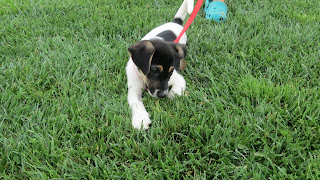Recently I discussed the location of your rabbit's cage, but I have gotten so MANY requests for some ideas and guidelines for creating the perfect "rabbitat."
Cages = a bad choice?
If you go the cage route, you need something that goes with the rabbit's breed and age. A cage with multiple ramps makes for a faulty cage if you are using it for a large or old rabbit, whereas a smaller spry, young rabbit may fit better with that option. I do not recommend cages very much, only because they are so expensive and so small. All cages have wires on the bottom, and ones that don't have any are "starter kits." Not only that, the cages are harder to clean.
Some Prefer Pens
I love puppy pens because there is easier clean-up(sweep out and DONE) and the rabbit gets more access to your daily life. Another reason I love pens because you can generally conform them to particular shapes creatively, and the one I use was cheaper. The pen can be left open for free-range rabbits; a smaller pen can be used solely for a safe hideaway for a rabbit, or it can be put out for the rabbit to stay in at night. I am a rabbit-pen-user at heart. They are comfortable, spacious, the rabbit has more access to your life, inexpensive, perfect for bunn-proofing, and easy to clean. Pens tend to give better ventilation and even if your rabbit is shy, you can find some creative ways to have a proper in-pen hut or shelter for the rabbit to retreat to.
Before starting....
Remember that although I do not prefer cages, some environments and households can find a way to use cages while still keeping the rabbit happy. Check both options first before deciding cages are a bad idea. Overall, cage, pen, WHATEVER, you always should purchase the best option for your rabbit, not for you. I know people don't like pens because they are big and don't look pretty, but (along with showing off your love for rabbits) it doesn't matter if the housing choice doesn't look good, it's the safety and comfort for the rabbit(and other household members) that counts!
Not a Rodent!
Even people who gravitate towards rabbits positively, still think rabbits are rodents. They are lagamorphs, meaning "hopping creature". Cage-whise, rabbits should only have cages just for them. Not ferrets, not rats, NOT chinchillas.... RABBITS! Even the most energetic rabbit cannot climb in the way a rodent could, so why would you give them a cage with ramps and ledges that only rodents can climb?
Pawse to consider- Rabbit's feet are JUST fur!
Another reason I don't like cages is because of the wire bottoms. Both rabbits are recovering from minor sore hocks(due to past cage-living history) and even in the pens, they have 24/7 resting pads and towels for comfort. They have no pads on the feet. Just thick hair! It's very important to consider a rabbit's feet when choosing a cage.
Hutches - No point!
No house rabbit owner I have met keeps their rabbits in a hutch. Hutches are MEANT to keep rabbits protected from harsh weather and predators, which they have no exposure to inside. Most hutches are off the ground, which I would find a problem when I open the pens to let them play and explore to their extent. Plus, all hutches are covered except for the mesh doors. This may provide protection for their outdoor counterparts, but all rabbits should be exposed and open to people walking and talking o rdin the home, which these types of habitats lack incredibly. PLUS, these expensive hutches are generally small and cause urine burn. All hutch residing rabbits are shy, and whenever the door is opened they will run to the back of the hutch, unexcited and frightened.
A final word
Whenever choosing a rabbitat, remember to consider the rabbit's needs and desires before choosing one on impulse because it looks "fancy" or "cool." The rabbits house is the most important part of your rabbit purchases. Remember to do research and think like a rabbit for housing options.
Continue the entire week with Rabbit Week: a fun critter post extravaganza!

















